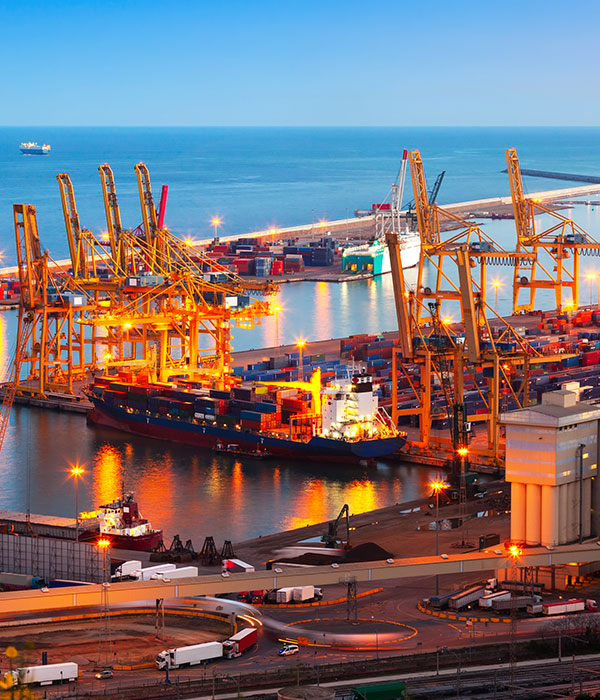Note: The wind direction of the international shipping market has changed (Asia-Europe international shipping prices have dropped significantly)
The market wind has changed! Spot freight rates for containers from Asia to Europe and across the Pacific have dropped significantly in the past week. Affected by the slowdown in demand, shipping companies have begun to cancel voyages and faced the pressure of price wars, indicating that the imbalance between supply and demand in the market has intensified and there is excess capacity.
In the last week, the spot freight rate of containers between Asia and Europe has shown a steady downward trend, especially on the routes from Asia to Northern Europe and Asia to the Mediterranean, which have experienced significant double-digit declines.
According to the Deluri World Container Index (WCI) data, the freight rate on the Shanghai-Rotterdam route fell by nearly US $1,000/FEU this week, a weekly drop of as much as 14%. At the same time, Xeneta's XSI index also reflected the drop in freight rates on the Asia-Europe route. 10% to US $6,843/FEU. Similarly, the spot freight rate on WCI's Shanghai-Genoa route fell 12% to US $5,842/FEU, and the freight rate on the Baltic Freight Index's Asia-Mediterranean route also fell 12% to US $6,274/FEU.
People in the European freight forwarding industry pointed out that the market direction has changed and spot rates are falling rapidly. The core challenge currently facing shipping companies is the slowdown in demand. Although capacity has been increased through the Cape of Good Hope to cope with the growing demand on Asia-Europe routes, demand seems to have reached its peak, and the high freight periods in May and June are over.
Container trade statistics further confirm this point. July data showed that monthly freight volume from the Far East to Europe declined, down nearly 200,000 TEUs from June, from 1.75 million TEUs in June to 1.58 million TEUs in July, a decrease of 0.5%. In particular, freight volume from North Asia to Northern Europe decreased by 7.6% month-on-month and 14.2% year-on-year, while freight volume from China to Northern Europe also decreased by 3.9% month-on-month, although it still increased by 7.9% year-on-year.
Freight forwarders expect August data to show a steeper month-on-month decline and a weaker demand outlook for September. As China's Golden Week approaches, empty ship activity is expected to increase, which may be the only strategy for shipping companies to slow down the decline in freight rates.
In response to market changes, shipping companies have begun to take action. For example, Hapag-Lloyd, a member of THE THE Alliance, announced that it will cancel five voyages from Asia to Northern Europe in weeks 40 to 42, and three voyages from Asia to THE Mediterranean in weeks 40 to 41.
In addition, the spot freight rate of the trans-Pacific route also showed a weak trend, although the decline was relatively small. The WCI freight rate of the Shanghai-Los Angeles route fell by 3%, and the XSI Trans-Pacific Index also fell by 3%. The trade situation from Asia to the east coast of North America was similar, and the WCI price of the Shanghai-New York route fell by 2%. Despite the potential threat of dockworkers' strikes on the East Coast and Gulf Coast of the United States, and analysts' forecasts for a surge in port traffic and spot freight rates on the West Coast, the freight rate of the Asia-North America route continued to decline.
注意:国际海运市场风向已变(亚洲-欧洲国际海运价格明显下降)
市场风向已变!亚洲至欧洲及跨太平洋集装箱现货运价近一周显著下降,受需求放缓影响,航运公司开始取消航次并面临价格战压力,显示市场供需失衡加剧及运力过剩.
最近一周,亚洲与欧洲之间的集装箱现货运价呈现稳步下降趋势,特别是在亚洲至北欧与亚洲至地中海的航线上,均出现了显著的两位数降幅.
据德路里世界集装箱指数(WCI)数据显示,上海至鹿特丹航线的运价本周下跌近1000美元/FEU,周跌幅高达14%.同时,Xeneta的XSI指数也反映出亚欧航线运价下跌10%,至6843美元/FEU.类似地,WCI的上海至热那亚航线现货运价下降了12%,至5842美元/FEU,波罗的海货运指数的亚洲至地中海航线运价亦下滑12%,至6274美元/FEU.
欧洲货代行业人士指出,市场风向已变,现货费率正在迅速回落.航运公司当前面临的核心挑战在于需求放缓,尽管已通过好望角增加运力以应对亚欧航线增长的需求,但需求似乎已达顶峰,五月与六月的高运费期已成过去.
集装箱贸易统计数据进一步印证了这一点,七月份数据显示,从远东至欧洲的月度货运量出现下滑,较六月份减少了近20万标准箱,从6月份的175万标准箱下降到7月份的158万标准箱,降幅为0.5%.特别是北亚至北欧的货运量环比下降7.6%,同比下降14.2%,而中国至北欧的货运量也环比下降3.9%,尽管同比仍增长7.9%.
货代预计,八月份的数据将显示更大幅度的环比下降,九月份需求前景疲软.随着中国黄金周的临近,空船活动预计会增加,这或许是航运公司减缓运费下滑的唯一策略.
为应对市场变化,航运公司开始采取行动.例如,THE联盟成员赫伯罗特宣布,将在第40至42周取消5个亚洲至北欧航次,并在第40至41周取消3个亚洲至地中海航次.
此外,跨太平洋航线的现货运价也呈现疲弱态势,尽管降幅相对较小.上海至洛杉矶航线的WCI运价下跌3%,XSI跨太平洋指数亦下降3%.亚洲至北美东海岸的贸易情况类似,上海至纽约航线WCI价格下跌2%.尽管面临美国东海岸和墨西哥湾沿岸码头工人罢工的潜在威胁,以及分析师对西海岸港口运输量和现货运费激增的预测,但亚洲至北美航线的运价仍持续下滑.












